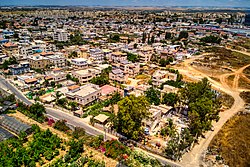
Back Lod Afrikaans اللد Arabic اللد ARZ Lod Azerbaijani Лод Byelorussian Lod Catalan Lod (lungsod) CEB Lod Czech Lod (Israel) Danish Lod German
Lod
| |
|---|---|
 | |
| Coordinates: 31°57′7″N 34°53′17″E / 31.95194°N 34.88806°E | |
| Country | |
| District | Central |
| Subdistrict | Ramla Subdistrict |
| Founded | 5600–5250 BCE (Initial settlement) 1465 BCE (Canaanite/Israelite town) |
| Government | |
| • Mayor | Yair Revivo |
| Area | 12,226 dunams (12.226 km2 or 4.720 sq mi) |
| Population (2022)[1] | |
| • Total | 85,351 |
| • Density | 7,000/km2 (18,000/sq mi) |
Lod (Hebrew: לוד, or fully vocalized לֹד; Arabic: اللِّد, romanized: al-Lidd or al-Ludd), also known as Lydda (Ancient Greek: Λύδδα), is a city 15 km (9+1⁄2 mi) southeast of Tel Aviv and 40 km (25 mi) northwest of Jerusalem in the Central District of Israel. It is situated between the lower Shephelah on the east and the coastal plain on the west. The city had a population of 85,351 in 2019.[1]
Lod has been inhabited since at least the Neolithic period.[2] It is mentioned a few times in the Hebrew Bible and in the New Testament.[3] Between the 5th century BCE and up until the late Roman period, it was a prominent center for Jewish scholarship and trade.[3][4] Around 200 CE, the city became a Roman colony and was renamed Diospolis (Ancient Greek: Διόσπολις, lit. 'city of Zeus'). Tradition identifies Lod as the 4th century martyrdom site of Saint George;[5][6] the Church of Saint George and Mosque of Al-Khadr located in the city is believed to have housed his remains.[3][7]
Following the Arab conquest of the Levant, Lod served as the capital of Jund Filastin; however, a few decades later, the seat of power was transferred to Ramla, and Lod slipped in importance.[3][8] Under Crusader rule, the city was a Catholic diocese of the Latin Church and it remains a titular see to this day.[citation needed]
Lod underwent a major change in its population in the mid-20th century.[9] Exclusively Palestinian Arab in 1947,[9] Lod was part of the area designated for an Arab state in the United Nations Partition Plan for Palestine; however, in July 1948, the city was occupied by the Israel Defense Forces, and most of its Arab inhabitants were expelled in the 1948 Palestinian expulsion from Lydda and Ramle.[10][11] The city was largely resettled by Jewish immigrants, most of them expelled from Arab countries.[12][13]
Today, Lod is one of Israel's mixed cities, with an Arab population of 30%.[14] Lod is one of Israel's major transportation hubs. The main international airport, Ben Gurion Airport, is located 8 km (5 miles) north of the city. The city is also a major railway and road junction.[3]
- ^ a b "Regional Statistics". Israel Central Bureau of Statistics. Retrieved 21 March 2024.
- ^ Commenge, Catherine. "Lod Newe Yarak: a roman pottery kiln and Pottery Neolithic A remains".
- ^ a b c d e "Lod | City, Israel, Palestine, & History | Britannica". britannica.com. Retrieved 25 June 2022.
- ^ Corpus inscriptionum Iudaeae/Palaestinae: a multi-lingual corpus of the inscriptions from Alexander to Muhammad. Vol. IV: Iudaea / Idumaea. Eran Lupu, Marfa Heimbach, Naomi Schneider, Hannah Cotton. Berlin: de Gruyter. 2018. pp. 77–85. ISBN 978-3-11-022219-7. OCLC 663773367.
{{cite book}}: CS1 maint: others (link) - ^ Mahoney, Lisa (2020-04-14), "Art and efficacy in an icon of St George *", The Eloquence of Art, Abingdon, Oxon; New York, NY: Routledge, pp. 188–203, doi:10.4324/9781351185592-11, ISBN 978-1-351-18559-2, S2CID 218824016, retrieved 27 June 2022,
By 1099 crusading armies had captured the city of Lydda, the site of St George's martyrdom and tomb.
- ^ Howell, David (1969). "St. George as Intercessor". Byzantion. 39: 121–136. ISSN 0378-2506. JSTOR 44169945.
- ^ Walter, Christopher (1995). "The Origins of the Cult of Saint George". Revue des études byzantines. 53 (1): 295–326. doi:10.3406/rebyz.1995.1911. ISSN 0766-5598.
- ^ Cite error: The named reference
:1was invoked but never defined (see the help page). - ^ a b Rabinowitz, Dan; Monterescu, Daniel (2008-05-01). "RECONFIGURING THE "MIXED TOWN": URBAN TRANSFORMATIONS OF ETHNONATIONAL RELATIONS IN PALESTINE AND ISRAEL - International Journal of Middle East Studies". International Journal of Middle East Studies. 40 (2): 208–210. doi:10.1017/S0020743808080513. ISSN 1471-6380. S2CID 162633906.
The Palestinian quarters of Safad, Tiberias, Haifa, Jaffa, and West Jerusalem and the Jewish quarter of the Old City of Jerusalem were in a state of sociological catastrophe, with no community to speak of to even bury the dead and mourn the old existence... By late 1949 only one of the five towns that had been effectively mixed on the eve of the war, namely, Haifa, still had a Palestinian contingent. Even there, however, the urban mix had been transformed beyond recognition. The 3,000 remaining Palestinians, now representing less than 5 percent of the original community, had been uprooted and forced to relocate to downtown Wadi Ninas... More relevant for our concerns here are Acre, Lydda, Ramle, and Jaffa, which, although exclusively Palestinian before the war of 1948, became predominantly Jewish mixed towns after. All of them had their residual Palestinian populations concentrated in bounded compounds, in one case (Jaffa) surrounded for a while by barbed wire. As late as the summer of 1949, all of these compounds were subjected to martial law.
- ^ Shapira, Anita, “Politics and Collective Memory: the Debate Over the 'New Historians' in Israel,” History and Memory 7 (1) (Spring 1995), pp. 9ff, 12–13, 16–17.
- ^ Blumenthal, 2013, p. 420
- ^ M. Sharon, s.v. "Ludd," Encyclopedia of Islam, 2nd ed. Leiden: Brill, 1983, vol. 5, pp. 798-803; ISBN 978-90-04-07164-3
- ^ Morris, 2004, pp. 414-461.
- ^ Uploads (p. 18), Jerusaleminstitute.org. Accessed 1 November 2022.

